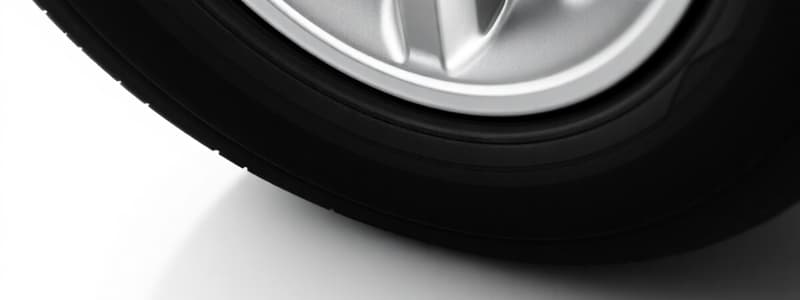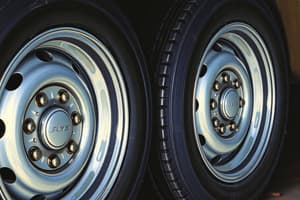Podcast
Questions and Answers
Which of the following is a primary function of tires in vehicle dynamics?
Which of the following is a primary function of tires in vehicle dynamics?
- To solely enhance the vehicle's aesthetic appeal.
- To directly control the vehicle's aerodynamic profile.
- To cushion the vehicle from road irregularities. (correct)
- To act as a rigid connector between the vehicle and the road.
The camber angle of a tire is defined by the angle between which of the following?
The camber angle of a tire is defined by the angle between which of the following?
- The wheel plane and the ground plane.
- The z-axis and the wheel plane. (correct)
- The x-axis and the wheel velocity vector.
- The y-axis and the ground plane.
In the context of a free-rolling tire, what is the effect of the offset ('a') of the resultant normal force from the contact patch center?
In the context of a free-rolling tire, what is the effect of the offset ('a') of the resultant normal force from the contact patch center?
- It equally distributes the normal force, preventing uneven wear.
- It has no effect on the tire's rotational dynamics.
- It creates a moment that aids the tire's rotation.
- It creates a moment that opposes the tire's rotation. (correct)
What fundamentally causes energy dissipation in a tire's rubber as it deforms?
What fundamentally causes energy dissipation in a tire's rubber as it deforms?
For a tire operating under free-rolling conditions, what equation best describes the relationship between the moment due to the offset of the normal force ($M_f$), the normal force ($F_z$), and the offset distance ($a$)?
For a tire operating under free-rolling conditions, what equation best describes the relationship between the moment due to the offset of the normal force ($M_f$), the normal force ($F_z$), and the offset distance ($a$)?
Which tire characteristic would typically result in a lower rolling resistance coefficient?
Which tire characteristic would typically result in a lower rolling resistance coefficient?
What is the approximate contribution of tire rolling resistance to the overall energy consumption of cars and light trucks, according to the data provided?
What is the approximate contribution of tire rolling resistance to the overall energy consumption of cars and light trucks, according to the data provided?
According to the provided image, which tire type and road surface combination would yield the lowest coefficient of rolling resistance?
According to the provided image, which tire type and road surface combination would yield the lowest coefficient of rolling resistance?
How does increasing internal tire temperature typically affect the rolling resistance coefficient ($f_r$) of a tire?
How does increasing internal tire temperature typically affect the rolling resistance coefficient ($f_r$) of a tire?
Based on the provided information, what effect does applying a braking effort have on the rolling resistance coefficient of a bias-ply tire?
Based on the provided information, what effect does applying a braking effort have on the rolling resistance coefficient of a bias-ply tire?
Flashcards
Tire Functions
Tire Functions
Support the vehicle's weight, cushion from road irregularities, provide driving/braking forces, and provide lateral forces for steering control & stability.
Slip Angle
Slip Angle
The angle in the ground plane between the x-axis and the wheel velocity vector.
Moment (Mf) in Free-Rolling Tire
Moment (Mf) in Free-Rolling Tire
Offset of resultant normal force from contact patch center that creates a moment opposing rotation in a free-rolling tire.
Tire Characteristics
Tire Characteristics
Signup and view all the flashcards
Hysteresis in Rubber
Hysteresis in Rubber
Signup and view all the flashcards
Factors Increasing Rolling Resistance (Tire Body)
Factors Increasing Rolling Resistance (Tire Body)
Signup and view all the flashcards
Factors Decreasing Rolling Resistance (Tire Body)
Factors Decreasing Rolling Resistance (Tire Body)
Signup and view all the flashcards
Factors Increasing Rolling Resistance (Surface)
Factors Increasing Rolling Resistance (Surface)
Signup and view all the flashcards
Factors Decreasing Rolling Resistance (Surface)
Factors Decreasing Rolling Resistance (Surface)
Signup and view all the flashcards
Study Notes
- Tires perform several key functions for vehicles
- Supporting vehicle weight
- Cushioning from road irregularities
- Providing driving and braking forces
- Providing lateral forces for steering
- Forces, excluding aerodynamics, are generated/borne by tires in four contact patches
- Each patch is about the size of a hand
- Aerodynamic forces are indirectly resisted
Tire/Wheel Geometry
- Key parameters include:
- Section width (WT)
- Tread width
- Section height (hr)
- Rim diameter
- Aspect Ratio
- Offset
- Tireprint width
- Pan width
- Sidewall
Tire Coordinate System
- Axis system is defined as:
- Origin at the center of contact patch
- X-axis: Intersection of wheel and ground plane
- Y-axis: In ground plane, perpendicular to X-axis
- Z-axis: Perpendicular to the ground, downward
- Slip angle (α): Angle in the ground plane between the x-axis and wheel velocity vector
- Camber angle (γ): Angle between z-axis and the wheel plane
- Camber angle is positive when the top of tire leans away from the vehicle center
Longitudinal Dynamics of Free-Rolling Tire
- Tires are flexible, thin-walled, toroidal pressure vessels
- They undergo large deformation due to weight
- Normal force generated by tire deformation is asymmetric due to hysteresis
- Offset "a" of normal force from contact patch center creates moment (Mf = Fz * a) opposing rotation
- A free-rolling tire has no moment applied around its axle
- Moment Mf must be balanced during steady-state motion
- Mf decelerates the tire, requiring force Fax to maintain speed
- Force Fax requires the existence of force Ff, where moment Ff * r balances the moment Mf
- Rolling resistance coefficient is defined as fr = Ff / Fz
Hysteresis of Typical Rubber
- Rubber does not return all deformation energy
- It dissipates some energy as heat due to internal friction between polymer molecules
Rolling Resistance Trends
- Greater rolling resistance (fr) is associated with:
- Tire Body: Bias-ply construction, smaller radius, natural rubber
- Inflation Pressure: Lower
- Surface: Rough, Soft, Wet
- Lower rolling resistance (fr) is associated with:
- Tire Body: Radial-ply construction, larger radius, synthetic rubber
- Inflation Pressure: Higher
- Surface: Smooth, Hard, Dry
Rolling Resistance Breakdown
- Percentage contributions of sources
- Material Hysteresis ~90%
- Air Resistance ~ 4%
- High Speed Deformation ~1%
- Tire Friction to Road ~5%
- Percentage contribution of tire components
- Tread Compound ~44%
- Bead Area ~6%
- Belt ~17%
- Body Ply ~26%
- Sidewall ~6%
- InnerLiner ~1%
Rolling Resistance Contribution
- For cars and light trucks: 20% of energy is used by tires to overcome rolling resistance
- For trucks: 30% of energy is used by tires to overcome rolling resistance
Typical Rolling Resistance Coefficients
- Rolling resistance coefficient (fr) for radial tires
- fr ≅ 0.008 V < 130 km/hr
- Rolling resistance coefficient (fr) for bias ply tires
- fr = 0.0169 + 0.19 x 10-6 V^2 V < 150 km/hr
Effect of Tire Construction, Pressure, and Temperature on Rolling Resistance
- The effect of rolling resistance on tire construction, pressure and temperature differ according to make and model
Effect of Pressure & Size on Rolling Resistance for Various Surfaces
- How pressure and size affects rolling resistance can vary significantly depending on the road surface
Effect of Longitudinal Forces
- Tractive and Breaking effort affect the rolling resistance of bias-ply tires
Studying That Suits You
Use AI to generate personalized quizzes and flashcards to suit your learning preferences.


